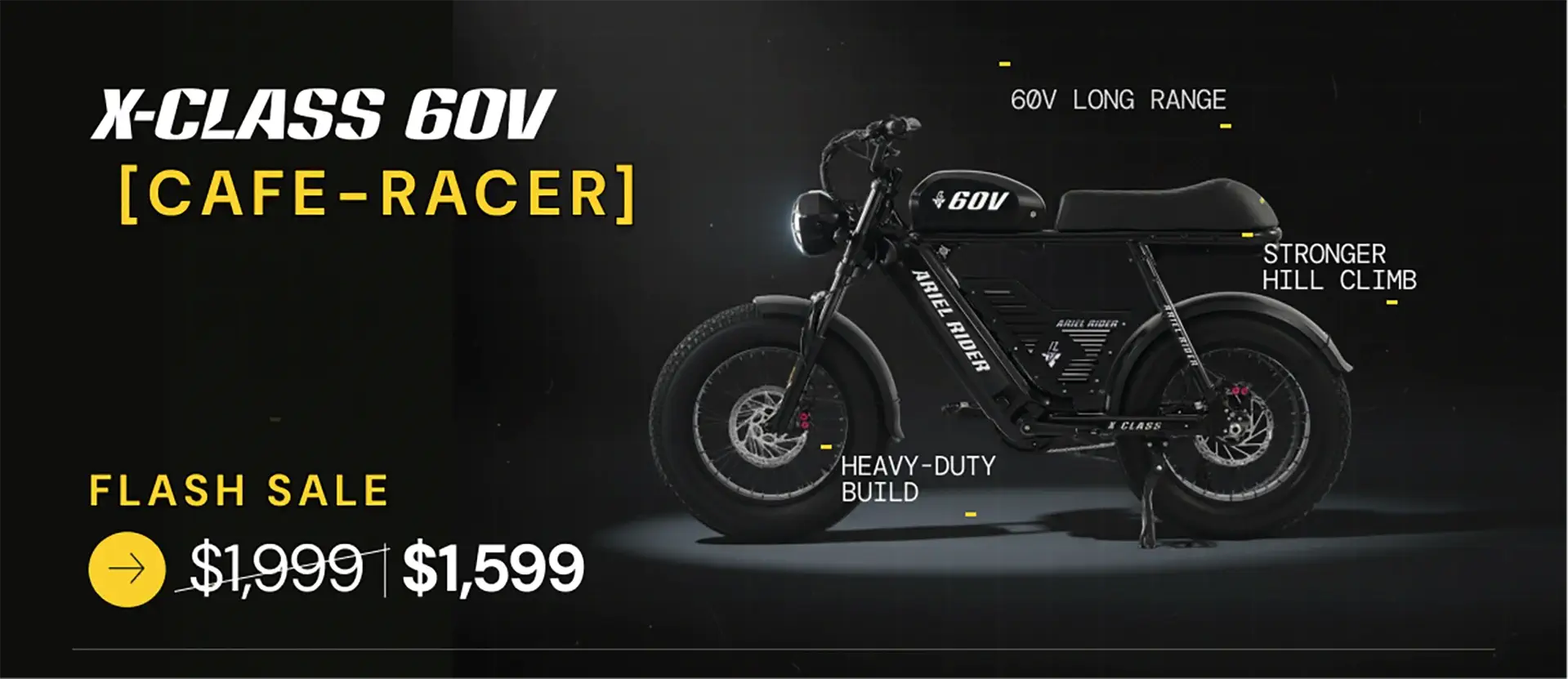It’s not exactly Ford versus Ferrari, but in the e-bike world 52 V versus 60 V has become the new pub debate. Both camps have a point. You cannot see volts on a spec sheet the way you see “1000 W,” but you can feel them the first time you hit the throttle on a hill. Let’s break down what the numbers really mean — and which voltage fits your kind of ride.
Quick refresher – what voltage actually does
Voltage is electrical pressure: the push that moves current through your motor. Higher voltage gives the system more headroom for speed and torque. In one line of math, Watts = Volts × Amps. Volts set the potential, amps set the flow. Raise volts and the motor can reach the same power with less current, which keeps heat down and efficiency up. Think of 52 V and 60 V as two gears in the same transmission — one tuned for balance, the other for brute force.
Real-world power – what you actually feel

A 52 V system delivers strong, predictable acceleration and a solid top speed that suits daily riders. A 60 V system pushes harder, delivering sharper launches and more torque at speed. With the same controller, the 60 V motor spins faster, but it is the combination of voltage and controller current that shapes the ride.

In typical factory tuning, 52 V bikes reach around 35 mph (where legally allowed) with 1000 W-class motors, while 60 V platforms extend that to 40 mph or more (where legally allowed) with a matching controller. Torque follows suit: about 90 Nm on many 52 V setups versus 110 Nm + on advanced 60 V models. Both are lively; one leans efficient, the other ferocious.
| Aspect | 52 V System | 60 V System |
|---|---|---|
| Acceleration | Strong, linear power; ideal for traffic and urban starts. | Instant throttle hit; quicker off the line and uphill. |
| Top speed | ≈ 35 mph (56 km/h) | ≈ 40–45 mph (64–72 km/h) |
| Heat & efficiency | Runs cool at commuter speeds; excellent range per Wh. | Lower current for same power; steadier torque under load. |
| Feel | Smooth, composed, confidence-inspiring. | Sharper, sportier, more aggressive. |
| Price | Lower battery and controller cost. | ≈ 10–15 % higher; upgraded components. |
Range myths – more volts does not always mean fewer miles

Range is determined by energy in watt-hours, not by voltage alone. A 52 V 15 Ah pack stores the same 780 Wh as a 60 V 13 Ah pack. Ride both at the same speed and you will cover similar ground. Because higher voltage draws fewer amps for the same output, it can be slightly more efficient, but real-world range depends far more on speed, terrain, and rider weight.
The difference comes from behavior, not the battery. Most riders with extra voltage use it — harder launches, higher speeds — which naturally trims range. Ride either bike at 20 mph and they perform nearly the same. Voltage simply gives you the choice between efficiency and excitement.
Price and compatibility
A 60V system costs a bit more because it uses additional battery cells and higher-rated electronics. Expect roughly a 10–15 percent premium for the pack and charger. The jump from 48V to 52V or 60V also changes supporting parts: controller, display, and sometimes lighting. Choose a bike designed around its voltage rather than attempting a swap — good engineering keeps the system balanced.
For many riders, 52V hits the sweet spot of performance and value. For others chasing hill-climb punch, 60V is worth the stretch. Both are purpose-built solutions, not one-up tricks.

Who should choose which voltage
- Choose 52 V if you ride daily in mixed terrain, value range, and want a quick, efficient commuter. It offers excellent balance between power and practicality.
- Choose 60 V if you live in steep or hilly areas, often ride two-up, or simply crave maximum torque and acceleration. It is the performance benchmark for riders who want more without jumping to 72 V motorcycle systems.
Ariel Rider builds both because riders are different. The 52 V platform is efficient, refined, and ideal for most daily use. The 60 V platform pushes into high-torque territory for those who measure fun in g-forces. One focuses on balance, the other on thrill — both engineered for real riders, not lab tests.
Pick your voltage, not a side
The real winner between 52 V and 60 V is the rider who chooses the right match. Voltage defines how an e-bike feels — how fast power reaches the wheel and how steady it stays on a climb. 52 V brings efficiency and range, 60 V brings raw torque. Either way, a well-tuned system will make you smile every time you twist the throttle.
Feel the difference voltage makes
Once you ride true 60 V torque — or experience how refined a modern 52 V system can be — you will understand why volts matter more than labels.




